Class 8 Maths NCERT Solutions Chapter 4: Practical Geometry
Ex – 4.1
Question 1.
Construct the following quadrilaterals:
(i) Quadrilateral ABCD
AB = 4.5 cm
BC = 5.5 cm
CD = 4 cm
AD = 6 cm
AC = 7 cm
(ii) Quadrilateral JUMP
JU = 3.5 cm
UM = 4 cm
MP = 5 cm
PJ = 4.5 cm
PU 6.5 cm
(iii) Parallelogram MORE
OR = 6 cm
RE = 4.5 cm
EO = 7.5 cm
(iv) Rhombus BEST
BE = 4.5 cm
ET = 6 cm
Solution.
(i) Steps of Construction
- Draw AB 4.5 cm
- With A as centre and radius AC = 7 cm, draw an arc.
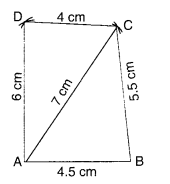
- With B as center and radius BC = 5.5 cm, draw another arc to intersect the arc drawn in step (2) at C.
- With A as center and radius AD = 6 cm, draw an arc on the side of AC, opposite to that of B.
- With C as center and radius CD = 4 cm, draw another arc to intersect the arc drawn in step (4) at D.
- Join BC, CD, DA, and AC.
Then, ABCD is the required quadrilateral.
(ii) Steps of Construction
- Draw JU = 3.5 cm
- With J as center and radius JP = 4.5 cm, draw an arc.
- With U as center and radius UP = 6.5 cm, draw another arc to intersect the arc drawn in step 2 at P.
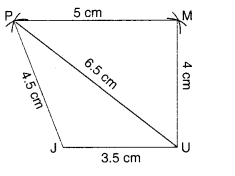
- With U as center and radius UM = 4 cm, draw an arc on the side of PU opposite to that of J.
- With P as center and radius PM = 5 cm, draw another arc to intersect the arc drawn in step 4 at M.
- Join UM, MP, PJ, and UP.
Then, JUMP is the required quadrilateral.
(iii) Steps of Construction
[We know that in a parallelogram, opposite sides are equal in length.
∴ MO = ER = 4.5 cm and ME – OR = 6 cm]
- Draw MO = 4.5 cm
- With M as center and radius ME = 6 cm, draw an arc.
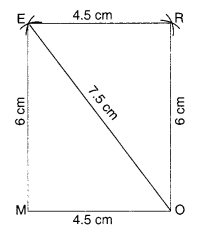
- With O as center and radius OE = 7.5 cm, draw an arc to intersect the arc drawn in step 2 at E.
- With O as center and radius OR = 6 cm, draw an arc on the side of OE opposite to that of M.
- With E as center and radius ER = 4.5 cm, draw another arc to intersect the arc drawn in step 4 at R.
- Join OR, RE, EM, and EO.
Then, MORE is the required parallelogram.
(iv) Steps of Construction
[We know that in a rhombus, all the sides are equal in length.
∴ BE = ES = ST = TB = 4.5 cm]
- Draw BE = 4.5 cm
- With B as centre and radius BT = 4.5 cm, draw an arc.

- With E as center and radius
ET = 6 cm, draw another arc to intersect the arc drawn in step 2 at T. - With E as center and radius
ES = 4.5 cm, draw an arc on the side of ET opposite to that of B. - With T as center and radius
TS = 4.5 cm, draw another arc to
intersect the arc drawn in step 4 at S. - Join ES, ST, TB, and TE.
Then, BEST is the required rhombus.
Ex – 4.2
Question 1.
Construct the following quadrilaterals:
(i) Quadrilateral LIFT
LI = 4 cm
IF = 3 cm
TL = 2.5 cm
LF = 4.5 cm
IT = 4 cm
(ii) Quadrilateral GOLD
OL = 7.5 cm
GL = 6 cm
GD = 6 cm
LD = 5 cm
OD = 10 cm
(iii) Rhombus BEND
BN – 5.6 cm
DE = 6.5 cm
Solution.
(i) Steps of Construction
- Draw LI = 4 cm.
- With L as center and radius LT = 2.5 cm, draw an arc.
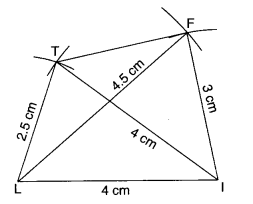
- With I as center and radius, IT = 4 cm, draw another arc to intersect the arc drawn in step 2 at T.
- With I as center and radius IF = 3 cm, draw an arc.
- With L as center and radius LF = 4.5 cm, draw another arc to intersect the arc drawn in step 4 at F.
- Join IF, FT, TL, LF and IT.
Then, LIFT is the required quadrilateral.
(ii) Steps of Construction
- Draw LD = 5 cm.
- With L as center and radius LG = 6 cm, draw an arc.
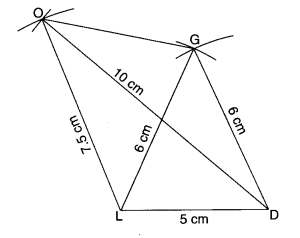
- With D as center and radius DG = 6 cm, draw another arc to intersect the arc drawn in step 2 at G.
- With L as center and radius LO = 7.5 cm, draw an arc.
- With D as center and radius DO = 10 cm, draw another arc to intersect the arc drawn in step 4 at O.
- Join DG, GO, OL, LG and DO.
Then GOLD is the required quadrilateral.
(iii) Steps of Construction
- Draw DE = 6.5 cm.
- Draw perpendicular bisector PQ of DE so as to intersect DE at M. Then M is the mid-point of DE.
- With M as centre and radius
=12×(5.6)=2.8cm
opposite sides of DE to intersect MP at N and MQ at B.
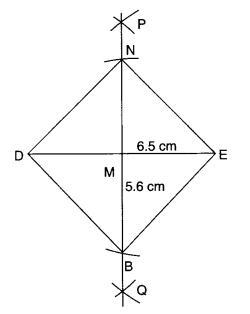
- Join DN, NE, EB, and BD.
Then, BEND is the required rhombus.
Ex – 4.3
Question 1.
Construct the following quadrilaterals :
(i) Quadrilateral MORE
MO = 6 cm
OR = 4.5 cm
∠M = 60°
∠O = 105°
∠R = 105°
(ii) Quadrilateral PLAN
PL = 4 cm
LA = 6.5 cm
∠P = 90°
∠A = 110°
∠N – 85°.
(iii) Parallelogram HEAR
HE = 5 cm
EA = 6 cm
∠R = 85°
(iv) Rectangle OKAY
OK = 7 cm
KA = 5 cm.
Solution.
(i) Steps of Construction
- Draw MO = 6 cm.
- At 0, draw ray OX such that Z MOX = 105°.
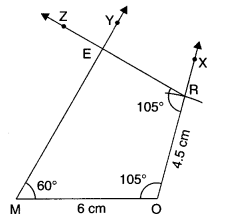
- Cut OR = 4.5 cm from ray OX.
- At M, draw ray MY such that ∠OMY = 60°.
- At R, draw ray RZ such that ∠ORZ = 105°.
- Let the rays MY and RZ meet at E.
Then, MORE is the required quadrilateral.
(ii) Steps of Construction
- Draw PL = 4 cm.
- At L, draw ray LX such that ∠PLX = 75°.
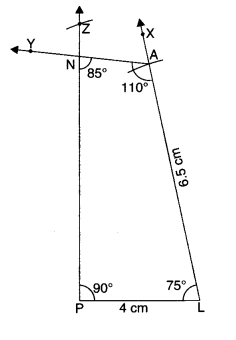
By Angle-sum property of a quadrilateral,
∠P + ∠A + ∠N + ∠L = 360°
⇒ 90° + 110° + 85° + Z L = 360°
⇒ 285° + ∠ L = 360°
⇒ ∠L = 360° – 285°
⇒ ∠L = 75°. - Cut LA = 6.5 cm from ray LX.
- At A, draw ray AY such that ∠LAY = 110°.
- At P, draw ray PZ such that ∠LPZ = 90°.
Let the rays AY and PZ meet at N.
Then, PLAN is the required quadrilateral.
(iii) Steps of Construction
- Draw HE = 5 cm.
- At E, draw ray EX such that ∠HEX = 85°
∴ Opposite angles of a parallelogram are equal.
∵ ∠E = ∠R = 85° - Cut EA = 6 cm from the ray EX.
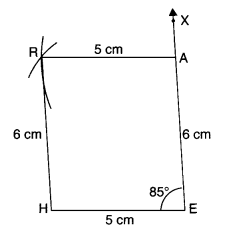
- With A as centre and radius AR = 5 cm, draw an arc.
- With H as centre and radius HR = 6 cm; draw another arc to intersect the arc drawn in step 4 at R.
∴ opposite sides of a parallelogram are equal in length
∵ AR = EH = 5 cm
and HR = EA = 6 cm - Join AR and HR.
Then, HEAR is the required parallelogram.
(iv) Steps of Construction
[We know that each angle of a rectangle
is 90°.
∴ ∠O=∠K=∠A=∠Y= 90°.
Also, opposite sides of a rectangle are equal in length.
∴ OY = KA = 5 cm and AY = KO = 7 cm]
- Draw OK = 7 cm.
- At K, draw ray KX such that ∠OKX = 90°.
- Cut KA – 5 cm from ray KX.
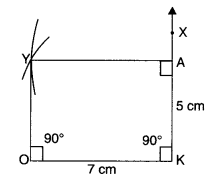
- Taking A as centre and radius AY = 7 cm, draw an arc.
- Taking O as centre and radius OY = 5 cm, draw another arc to intersect the arc drawn in step 4 at Y.
- Join AY and OY.
Then OKAY is the required rectangle.
Ex – 4.4
Question 1.
Construct the following quadrilaterals:
(i) Quadrilateral DEAR
DE = 4 cm
EA = 5 cm
AR = 4.5 cm
∠E = 60°
∠A = 90°
(ii) Quadrilateral TRUE
TR = 3.5 cm
RU = 3 cm
UE = 4 cm
∠R = 75°
∠U= 120°
Solution.
(i) Steps of Construction
- Draw DE = 4 cm.
- At E, draw ray EX such that ∠DEX = 60°.
- From ray EX, cut EA = 5 cm.
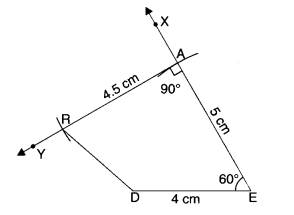
- At A, draw ray AY such that ∠EAY = 90°.
- Cut AR = 4.5 cm from ray AY.
- Join RD.
Then, DEAR is the required quadrilateral.
(ii) Steps of Construction
- Draw TR = 3.5 cm.
- At R, draw ray RX such that ∠TRX = 75°.
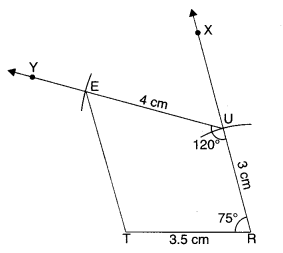
- Cut RU = 3 cm from ray RX.
- At U, draw ray UY such that ∠RUY = 120°.
- Cut UE = 4 cm from ray UY.
- Join ET.
Then, TRUE is the required quadrilateral.
Ex – 4.5
Question 1.
Draw the following:
1. The square READ with RE = 5.1 cm.
2. A rhombus whose diagonals are 5.2 cm and 6.4 cm long.
3. A rectangle with adjacent sides of lengths 5 cm and 4 cm.
4. A parallelogram OKAY where OK = 5.5 cm and KA = 4.2 cm. Is it unique?
Solution.
1. Steps of Construction
- Draw RE = 5.1 cm.
- At R, draw a ray RX such that ∠ERX
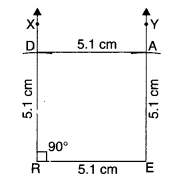
- From ray RX, cut RD = 5.1 cm.
- At E, draw a ray EY such that ∠REY = 90°.
- From ray EY, cut EA = 5.1 cm.
- Join AD.
Then, READ is the required square.
2. Steps of Construction
[We know that the diagonals of a rhombus bisect each other at right angles. So in rhombus ABCD, the diagonals AC and BD will bisect each other at right angles.]
- Draw AC = 5.2 cm.
- Construct its perpendicular bisector. Let it intersect AC at O.
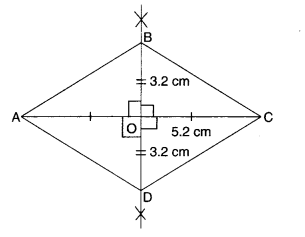
- Cut off 6.42= 3.2 cm lengths on either side of the bisector drawn in step 2, we get B and D.
- Join AB, BC, CD, and DA.
Then, ABCD is the required rhombus.
3. Steps of Construction
[We know that each angle of a rectangle is 90°. So, in rectangle PQRS,
∠P=∠Q=∠R=∠S= 90°.
Also, opposite sides of a rectangle are parallel.
So, in rectangle PQRS,
PQ || SR and PS || QR]
- Draw PQ = 5 cm.
- At Q, draw a ray QX such that ∠PQX = 90°.
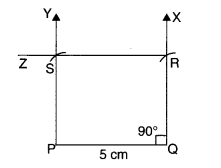
- From ray QX, cut QR = 4 cm.
- At P, draw a ray PY parallel to QR.
- At R, draw a ray RZ parallel to QP to meet the ray drawn in step 4 at S.
Then, PQRS is the required rectangle.
4. Steps of Construction
[We know that in a parallelogram, opposite sides are parallel and equal. So,
OK = YA and OK || YA;
KA = OY and KA || OY]
- Draw OK = 5.5 cm.
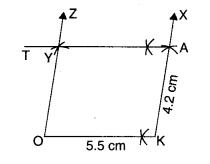
- At K, draw a ray KX at any suitable angle from OK.
- From ray KX, cut KA = 4.2 cm.
- A, draw a ray AT parallel to KO.
- At O, draw a ray OZ parallel to KA to cut the ray drawn in step 4 at Y.
Then, OKAY is the required parallelogram.
This is not unique.
Note: We can construct countless parallelograms with these dimensions by varying ∠OKA
